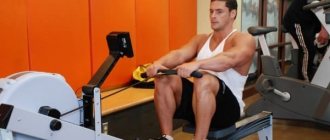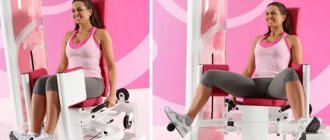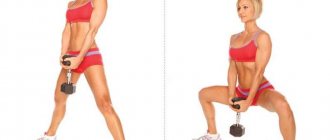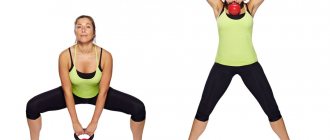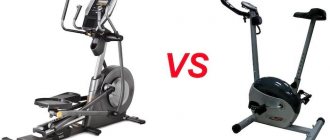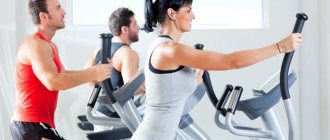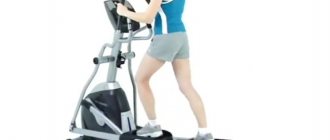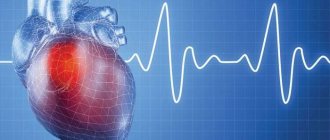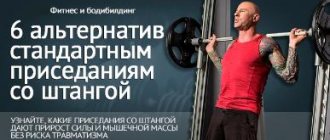Quadriceps
The quadriceps, or quadriceps muscles, which run from the pelvic bone to the knee, or more simply put, the muscles of the thighs, are intensively trained when exercising on an elliptical trainer. These are the areas that are most often problematic. In men - due to the lack of desired muscle mass, and in women - due to excess fat and cellulite. During training on an elliptical, the quadriceps bear the main load. The main advantage of the elliptical trainer over any other cardio machines is that it can train not only the front, but also the back muscles of the thigh by performing backward steps (read how to properly exercise on an elliptical trainer).
Features of training on an elliptical trainer
First of all, remember: you need to start exercising on the elliptical with a warm-up, otherwise you risk loading “unstretched” muscles, thereby injuring them. Warm-up should be light, short and involve all major muscle groups. You can perform exercises for the shoulder girdle, bending, and squats. Those who work out at the gym benefit from having a qualified fitness instructor show you how to do an effective warm-up.
It is important to monitor your heart rate while using the elliptical trainer. For beginners, the optimal rate is 110–120 beats per minute. For those who are in good physical shape, a higher level of training intensity is needed. During your first sessions, your heart rate should be around 65–70% of your maximum age-related heart rate. In the future, the figure can reach up to 80%. Following this rule will help you strengthen your cardiovascular system by preventing excessive stress on your heart during exercise.
Pay attention
Maximum age-related heart rate (AHR) can be calculated using the formula: 220 minus your age.
Despite the importance of tracking your heart rate, you should not become a hostage to constant measurements. The indicator should become only a kind of guideline.
You should start exercising on the elliptical trainer 1-2 hours after meals and no later than 2 hours before bedtime.
Calf muscles
Training your calves on an elliptical machine is slower than training your glutes or quads because the load on them is slightly lower. However, these areas tend to be the least problematic in terms of excess fat. The main mistake of novice athletes is that they move their legs following the impulse of the simulator itself, in other words, simply relaxing and moving by inertia, so the calf muscles end up receiving a minimum load. With the correct resistance and inclination of the simulator, and provided that the impulse comes from the person’s body and not from the machine, the calf muscles will receive enough load.
Effective elliptical trainer: what muscles work
The fundamental difference between an ellipsoid trainer is that almost all muscle groups are involved in the training process. In this case, the muscles of the lower body work more and the muscles of the upper body work slightly less. The muscles of the back, supporting corset and abdominal muscles are also not excluded. Experts say the main advantage of the equipment is the reduction to zero impact load on joints and ligaments.
Legs
- Quadriceps femoris or quadriceps . These are the muscles that run from the knee to the pelvic bone. They begin to work when the leg is straightened and moved forward. It is in the places where these muscles pass that cellulite usually occurs in women and excess adipose tissue grows, and in men there is often a lack of muscle mass.
- Gluteal muscles (biceps and biceps) . The elliptical works not only the front muscles, which is why it is considered practically the best of all cardio machines, but also the rear ones, when moving in the opposite direction. Moreover, the effectiveness of exercises on the simulator is many times greater than regular squats. If you bend your legs slightly, simultaneously increasing the resistance and inclination, the exercises become even more effective.
- Gastrocnemius . The buttocks and quadriceps are trained better on the elliptical, but these muscles also work quite effectively on it. True, usually the least problems arise in the calf area, because fat is reluctant to accumulate there, and it is consumed first. To maximize the load, you need to set the incline correctly, and most importantly, make sure that the driving impulse comes from your body and not from the machine.
Frame
- Deep back muscles . These muscles have a specific function; they support our body in the correct position. You can work them out better when you don’t hold on to the handrails.
- Abdominal, oblique and rectus abdominal muscles . They also work better when training occurs “without hands”. At the same time, it is advisable to control them throughout the entire workout, keeping them in full tension, then they will begin to work effectively, and excess fat layers will begin to leave this area, which is often considered problematic in men and women.
Upper body
- Muscles of the back and supporting corset. They begin to work when you pull the handles towards you.
- Breasts. They are activated, on the contrary, when pushing away the levers with your hands, according to the principle of ski poles.
- Triceps and biceps shoulders. These muscles work during flexion and extension of the arms. Exercises on an ellipsoid are suitable for those who want to burn excess fat in the shoulders and arms, as well as for building muscle mass if there is a lack of it, as well as creating a beautiful relief.
Having figured out which muscle groups are trained by the elliptical trainer, you can build a training plan according to your needs.
We must not forget that the main muscle that works hard during cardio exercise is the heart. At the same time, thanks to faster blood circulation, all metabolic processes in your body become much more intense. This directly affects the improvement of physical condition, increasing the overall endurance of the body, as well as normalizing weight while actively burning excess calories.
Arm muscles
The second most important advantage of the elliptical trainer after minimal impact on the joints is the presence of movable handles, with the help of which you can develop the muscles of the arms and chest. The handles work on a similar principle to ski poles: the arms tense when moving them towards you and away from you. Using an elliptical trainer you can develop triceps and biceps, which is especially important for people with low muscle mass, as well as for those who have fat deposits on their arms in the area from the shoulder to the elbow.
Advantages of the elliptical trainer
This equipment can be used both for warming up and for full training. But in order to know how to properly exercise on an elliptical trainer, you need to decide on your goals: losing weight, getting healthy, staying in physical shape. In any case, the ellipsoid has a minimum number of contraindications and is characterized by the following advantages:
- With the help of an ellipsoid, it is possible to load those muscle groups that remain unused on other types of simulators. For women who are watching their figure, this equipment is good because it allows you to work on the hips and buttocks - those problem areas that require a lot of effort to keep in optimal shape. This is much easier to achieve with an ellipsoid.
- It becomes possible to harmoniously develop the muscles of the back, chest, shoulder girdle and legs; depending on the groups of exercises used, you can emphasize the load on certain areas of the body.
- For those people who have problems with the spine or joints of the legs, the ellipsoid can become a lifesaver that will allow them to carry out full training without loading problem areas.
- Since ellipsoids belong to the category of cardiovascular exercise equipment, their use is recommended as a means of training the cardiovascular system, helping to stabilize blood pressure, which is especially important for older people.
- Finally, one cannot fail to mention the anaerobic properties of the ellipsoid: regular training increases endurance, promoting better absorption of oxygen. We recommend you learn: how to choose an exercise machine for your home
Abdominal muscles. Press
The abdominal muscles are less involved during a typical elliptical workout. However, if you perform special exercises, you can tighten your stomach and abs well. For example, when training, you can turn off the handles and rotate the pedals, turning your body left and right, keeping your hands at chest level (read about the training program on the elliptical trainer). With this exercise, the abs and oblique abdominal muscles will be actively strengthened. It is important that the entire body is straight and level while performing this exercise. A slouched back can significantly reduce the strain on your abdominal muscles.
Check out our range of orbitreks from the world's best
Elliptical training program for weight loss
- To achieve progress in losing weight, you need to exercise on the elliptical for 30-60 minutes daily or every other day.
- The load should be increased gradually, starting small. This applies to both increasing the load from week to week and increasing the parameters in each lesson.
- You can increase the duration of training on the elliptical by 5-10 minutes weekly or once every 2 weeks.
- It is important to understand that the elliptical is primarily a cardio machine, so to achieve better results in losing weight, it is advisable to use it in combination with strength training at home or in the gym.
- It is necessary to adjust the loads by “listening” to your body.
During classical walking
The body is positioned vertically, hands hold the movable handles. Walking is as close to natural as possible. Cardio exercise can be performed on any elliptical trainer, which muscles are involved:
- shoulder girdle;
- backs;
- breasts;
- hips;
- shins;
- belly.
The gastrocnemius is the first to be included in the work, followed by the posterior and anterior femoral. When running straight, the stomach curls slightly, allowing you to pump up your abs. By using your hands, the load can be felt in the biceps and triceps, and the rear delta. The back stabilizers are strengthened, which reduces pain from a sedentary lifestyle and improves posture.
What muscles does the elliptical trainer train?
During exercises on the orbit track, many muscle groups are involved:
- deltoids, biceps and triceps;
- abdominal Press;
- buttocks;
- back;
- breast;
- anterior and posterior surface of the thigh.
Including the most important – cardiac. Accelerated blood and accelerated metabolism help the user feel better, improve their weight, and adapt to cardio exercise.
The load distribution is uniform and depends on the selected complexes. In some, the emphasis is on the lower legs, in others on the chest and shoulders, in others on the buttocks. Platforms, movable and static handles help in training. Of no small importance is the user’s posture, speed of execution and preparedness, that is, warming up and performing other exercises before cardio training on the orbit track.
